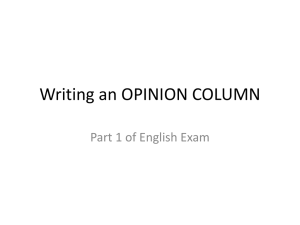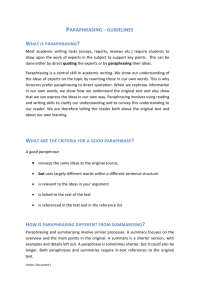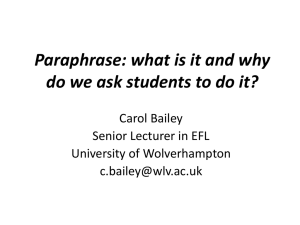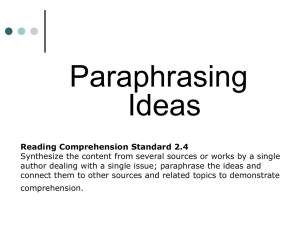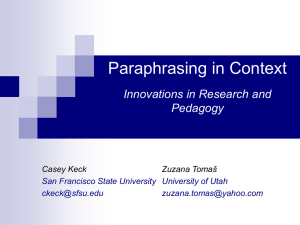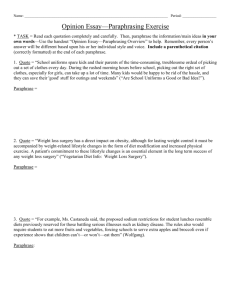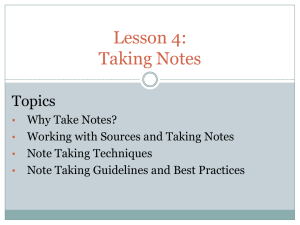Guidelines for paraphrasing
advertisement
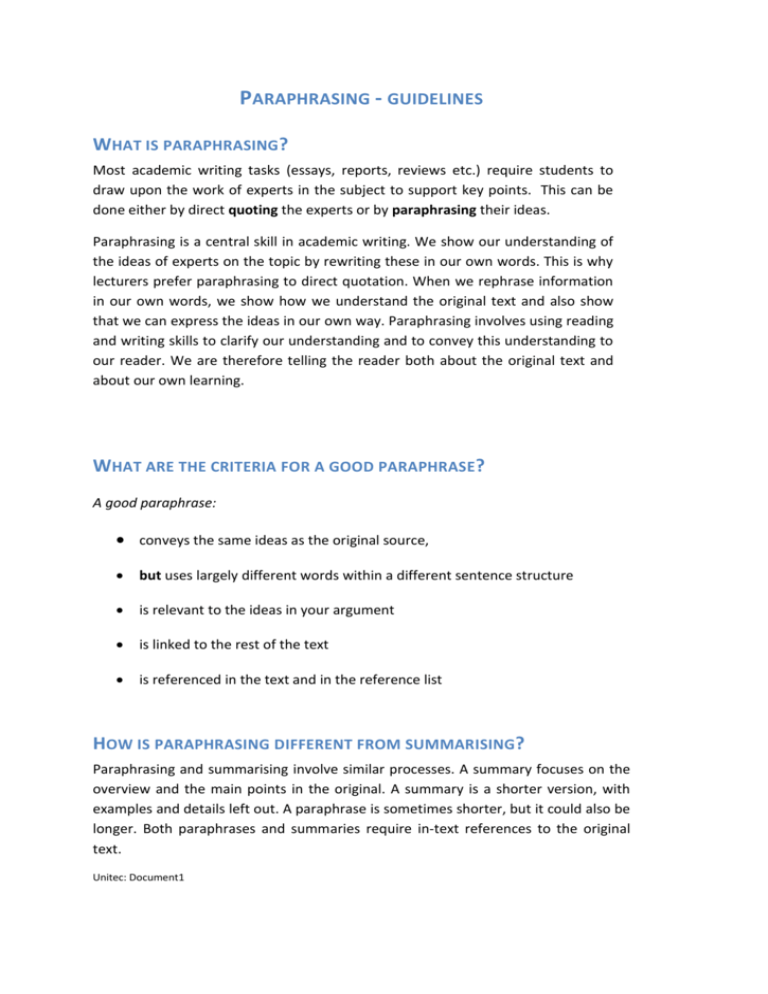
PARAPHRASING - GUIDELINES WHAT IS PARAPHRASING? Most academic writing tasks (essays, reports, reviews etc.) require students to draw upon the work of experts in the subject to support key points. This can be done either by direct quoting the experts or by paraphrasing their ideas. Paraphrasing is a central skill in academic writing. We show our understanding of the ideas of experts on the topic by rewriting these in our own words. This is why lecturers prefer paraphrasing to direct quotation. When we rephrase information in our own words, we show how we understand the original text and also show that we can express the ideas in our own way. Paraphrasing involves using reading and writing skills to clarify our understanding and to convey this understanding to our reader. We are therefore telling the reader both about the original text and about our own learning. WHAT ARE THE CRITERIA FOR A GOOD PARAPHRASE? A good paraphrase: conveys the same ideas as the original source, but uses largely different words within a different sentence structure is relevant to the ideas in your argument is linked to the rest of the text is referenced in the text and in the reference list HOW IS PARAPHRASING DIFFERENT FROM SUMMARISING? Paraphrasing and summarising involve similar processes. A summary focuses on the overview and the main points in the original. A summary is a shorter version, with examples and details left out. A paraphrase is sometimes shorter, but it could also be longer. Both paraphrases and summaries require in-text references to the original text. Unitec: Document1 HOW IS PARAPHRASING DIFFERENT FROM QUOTING? Paraphrasing… Quoting… When we paraphrase we take information written by another writer and express this in a different way, using different words. This process is often called ‘putting the information into your own words’. Each paraphrase needs a reference to the original text. In quoting you use the exact words of the author, and these are usually placed in quotation marks or, if longer, as indented text. Each quote needs to include a reference to the original text and a page number. Example: Example: The key advantages of email are that it is simple to use and asynchronous which means that a message can be sent at any time without the receiver needing to be available at the same time. A receiver can respond more carefully than if, for example, they were responding to a phone call (Mundell, 2005). Mundell (2005) highlights some benefits of email, “apart from ease of use, email has other advantages. Because it is asynchronous, people can send and receive messages without the need for the other party to be immediately available. This may allow respondents to construct a more thoughtful reply than would be the case during a conventional phone conversation or personal discussion” (p. 199). PARAPHRASING EFFECTIVELY HELPS AVOID PLAGIARISM It’s important to communicate the same meaning as the ideas in the original text, but to do so in different words. This can’t be done just by substituting some words for their synonyms alone. It requires more substantial changes to sentence structure. Unitec: Document1 STEPS IN PARAPHRASING In paraphrasing we aim to generate our own phrases and sentences which explain the ideas in the original. 1 Read the source text to get the general idea (gist). It’s helpful to skim it quickly first and then read it through in more detail to make sure you understand the main ideas. Some people find it helpful to highlight or underline key ideas on a photocopy. 2 Look away from the text and think about the ideas you’ve just read. This is an important step as it helps you to identify the key ideas that are relevant to you and helps you start to reconstruct the ideas your own words. 3 Start rewriting the key ideas, putting the text into your own words. This can be difficult if you keep looking at the source text. 4 It’s a good idea to work on paraphrasing the ideas in the section of text or paragraph rather than focusing on single sentences – You could: Use a different word order as well as different words. By starting a sentence in a different way you will be more likely to use different words: Culture shock is… change to People experience culture shock when… Use synonyms or words of similar meaning: merge with change to integrate; reject change to dismiss Change the forms of words: nouns – verbs; nouns to adjectives etc.: Impact on the environment change to environmental effects Use different lengths of sentence and different linking words See the use of these different techniques in the longer examples of paraphrasing given below. 5 Return to the original text. Compare your paraphrase to check whether your paraphrase keeps to the meaning intended by the writer of the original. Add the in-text reference. Unitec: Document1 POINTS TO CONSIDER WHEN PARAPHRASING: One general guideline for paraphrasing is not to copy groups of more than 3 words from the original – if you want to copy more, you should treat it as a quote. Sometimes you will need to copy some individual words exactly because a synonym may alter the meaning significantly, or because the word is a commonly used term in the field. Paraphrasing is a good activity for helping build vocabulary knowledge. Crosscheck meanings of synonyms in an English dictionary or a thesaurus. When writing an assignment you should be paraphrasing from a number of different sources. Practice paraphrasing as you make notes. All sources you paraphrase or quote from must be referenced. It’s common to have to draft and re-draft paraphrases. Some sections of text will be more difficult than others. WHEN TO PARAPHRASE There are several considerations to think about when deciding whether to paraphrase or quote from an original source including: How difficult it is to paraphrase How many quotations you have used throughout your assignment. Quotations should be used sparingly in your writing. How long the original text is. It is generally better to paraphrase/summarise rather than quote long sections of text. Sometimes the original text is particularly interesting or well written and because of this you may choose to quote rather than paraphrase. Unitec: Document1
